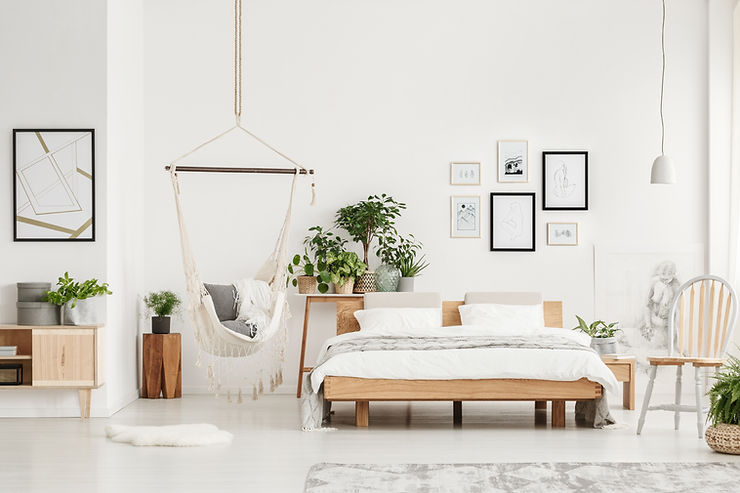Creating Tranquil Spaces: A Guide to Relaxing Home Design
- Alta Price

- Jan 23, 2024
- 3 min read
As we progress through the first month of 2024, having dedicated time to cleaning, organizing, and enhancing our self-care habits, it's now time to transform our homes into sanctuaries of relaxation and rejuvenation. This blog post offers insights into creating serene spaces by effectively using textures, colors, and organized environments.

1. Texture Therapy:
Plush Comfort: A shaggy rug in your living room adds a cozy, inviting touch.
Velvet Elegance: Velvet throw pillows on sofas or armchairs bring luxury and comforting texture.
2. Color Psychology for Calm:
Explore the calming influence of soft blues, gentle greens, and especially earthy neutrals.
Tranquil Blues: Incorporate shades of blue in accessories or wall colors to evoke calmness and peace.
Nature-Inspired Greens: Use green tones in fabrics or plants to create a refreshing, natural ambiance.
Earthy Neutrals: Embrace the grounding effect of earthy neutrals. Think beige, soft browns, warm grays, and creamy whites. These colors can be used in wall paints, furnishings, and decor to create a harmonious, calming space. They are versatile and blend seamlessly with other design elements, making them a favorite for a timeless, serene interior.
3. Clutter-Free Zones:
Apply decluttering techniques like the KonMari method and minimalism.
Designated Storage: Use stylish baskets or hidden storage solutions to keep clutter out of sight.
Regular Decluttering: Schedule weekly sessions to maintain a tidy, peaceful environment.
4. The Power of Aromatherapy:
Explore the calming effects of aromatherapy with essential oils and diffusers.
Lavender for Relaxation: Use lavender-scented oils to promote a relaxing atmosphere in bedrooms.
Citrus for Energy: Introduce citrus scents in workspaces to boost energy and focus.

5. Personal Retreats:
Designate areas for personal relaxation like a cozy reading corner or a meditative space.
Reading Nook: Set up a comfortable chair with good lighting and a small bookshelf.
Meditation Area: Create a quiet corner with cushions, calming colors, and minimal distractions.
6. Creating Zen Gardens (Indoor and Outdoor):
Embrace the elements of Zen gardens to bring tranquility both inside and outside your home.
Simplistic Landscaping (Outdoor): Use rocks, sand, and sparse plantings for a minimalist, calming outdoor garden. This approach emphasizes the beauty of simplicity and nature’s own design.
Water Features (Outdoor): Add a small fountain or a birdbath to your garden for soothing sounds and a visually appealing element.
Indoor Zen Elements: Replicate Zen garden principles indoors with small rock gardens, sand trays, or indoor water features. These can be excellent focal points for meditation or relaxation areas within your home.
Bonsai Trees (Indoor): Incorporate bonsai trees as a way to bring the essence of Zen gardening indoors. Their meticulous care and unique beauty add a peaceful and grounding element to any room.

7. Artistic Expression:
Encourage personal art or DIY projects for a relaxing atmosphere.
Gallery Wall: Create a gallery wall with personal photos or art for a unique, comforting display.
Craft Area: Dedicate a space for crafts and hobbies to encourage creative relaxation.
8. Hygge-Inspired Living:
Delve into the Danish concept of "hygge" which emphasizes coziness, comfort, and connection. For achieving hygge-inspired interiors:
Candlelit Evenings: Place unscented candles around your living room for a warm, peaceful ambiance.
Soft Throws: Drape knitted throws over furniture to add physical warmth and a sense of comfort.
9. Nature's Influence:
Wooden Accents: Use wooden elements in your decor for a natural, earthy feel.
Indoor Greenery: Bring in houseplants like succulents or snake plants to purify the air and create a serene, green environment.

10. Digital Detox Zones:
Create areas in your home free from digital devices, focusing on mindfulness and relaxation activities.
Conclusion:
In the quest for tranquility within our homes, the importance of creating spaces that resonate with our personal aesthetic and promote relaxation cannot be overstated. As we have explored, the harmonious blend of textures, the mindful use of color, especially the soothing palette of earthy neutrals, and the organization of our living spaces play pivotal roles in crafting environments conducive to calm and rejuvenation.
As we continue to navigate through 2024, let these principles be a guiding light in transforming our homes into sanctuaries. Remember, the journey to a serene and tranquil home is ongoing and ever-evolving. It's about creating a space that not only looks aesthetically pleasing but also feels like a personal retreat, a place where you can unwind, reflect, and rejuvenate.
Your home is more than just a place to live; it's a canvas for expressing your personal style and a haven for nurturing your well-being. So, embark on this journey of creating a tranquil space, and let your home be a reflection of your quest for peace, comfort, and happiness.








Mga Komento